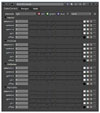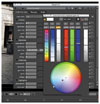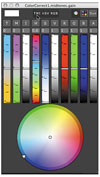- Understanding Nuke's Approach to Color
- Color Manipulation Building Blocks
- Using an I/O Graph to Visualize Color Operations
- Creating Curves with ColorLookup
- Color Matching with the Grade Node
- Achieving a "Look" with the ColorCorrect Node
Achieving a "Look" with the ColorCorrect Node
Giving an image a "look" is a very different practice than matching color. While matching color has a very specific purpose and methodology, giving an image a look refers to an artistic practice that gives an image a different feel to how it was shot. For example, you might want it to look brighter, warmer, or colder, depending on the feeling you want to create.
Using the ColorCorrect node
The ColorCorrect node is a very good tool to use for this as it has a lot of control over the different parts of the image—even more control than the Grade node. But as with everything else, it is still made out of the basic mathematical building blocks covered in the beginning of this chapter.
Let's bring in an image and give it a look.
- Press Ctrl/Cmd-W to close the color matching script and start a new one.
- Press the R key and bring in, from the chapter04 folder, the Car.png image again.
- While the newly imported Read1 node is selected, press the C key to create a ColorCorrect node. You can also find the ColorCorrect node in the Color toolbox.
View ColorCorrect1 in the Viewer (FIGURE 4.42).

Figure 4.42 The ColorCorrect node's Properties panel.
As you can see in ColorCorrect1's Properties panel, the ColorCorrect node includes controls for Saturation, Contrast, Gamma, Gain (Multiply), and Offset (Add). This is performed over either the whole dynamic range—called Master—or parts of the dynamic range called Shadows, Midtones, and Highlights. This makes creating a look somewhat easier.
This idea of midtones, highlights, and shadows changes from image to image. An image of a dark room will have no whites, but in that darkness one can still define that the brighter areas will be that image's highlights, the slightly lighter blacks will be midtones, and the darkest colors shadows. This can also be defined in the ColorCorrect node's Ranges tab.
Click the Ranges tab in ColorCorrect1's Properties panel.
In this tab (similar to ColorLookup, isn't it?) you have three graphs, all selected. One represents the shadows, another the midtones, and a third the highlights (FIGURE 4.43).

Figure 4.43 ColorCorrect's Ranges is a lookup curve that defines the brightness ranges.
Check the Test check box at the top of the graph.
This shows a representation in the Viewer of what parts of the image are shadow, midtone, and highlight. Highlights are represented by white, midtones as gray, and shadows as black. Green and magenta areas represent a mix of two ranges (FIGURE 4.44).

Figure 4.44 The test shows the parts of the dynamic range in the Viewer.
Click the Test button at the top of the graph again to turn it off.
The ranges are fine for this image, so we won't change anything and we will continue working.
Switch back to the ColorCorrect tab.
You will now give this image a dreamy, car-commercial look—all soft pseudo blues and bright highlights. If you don't define the "look" you are after in the beginning, you can lose yourself very quickly.
Before changing the color of this image, I'll show you my preferred interface setup for color correcting.
- In ColorCorrect1's Properties panel, click the Float controls button (looks like two boxes). This will float the Properties panel instead of docking it in the Properties Bin (FIGURE 4.45).

Figure 4.45 Click this button to float the Properties panel.
Hover your mouse pointer in the Viewer and press the Spacebar to maximize the Viewer to the size of the whole interface (FIGURE 4.46).

Figure 4.46 This is a good way to set the interface for color correction.
Since the Properties panel is floating, it is still there. This way, you can look at the image at its maximum size without wasting space on things like the DAG yet still be able to manipulate the ColorCorrect node.
What I am aiming for is something like that in FIGURE 4.47. You can try to reach that yourself, or you can follow my steps point by point.

Figure 4.47 This is the image look I am referring to.
- I'll start by desaturating the whole image a little, so in the Master set of properties I set the Saturation property to 0.5.
- Now for the shadows. I would like to color the shadows a little bluer than normal. Click the Color Wheel button for shadows.gamma.
From the Hue slider, choose a blue hue. I selected 0.6. Now display Saturation for the shadows.gamma color. I set it to 0.31. Finally, adjust the brightness, or Value, slider in the Color Wheel and Color Sliders panel. I have 1.22 (FIGURE 4.48).

Figure 4.48 Setting the shadow's Gamma properties using the Color Wheel and Color Sliders panel.
This results in RGB values of 0.8418, 0.993, and 1.22, respectively. It gives the image a nice-looking blue shadow tint. Notice that there are actually no hue and saturation sliders in the real Properties. The hue and saturation sliders in the Color Wheel and Color Sliders panel are only there so it will be easier to set the RGB sliders.
- Close this Color Wheel and Color Sliders panel.
- You have a lot more work in the midtones. First, set the Saturation to 0, so that the midtones are tinted black and white.
- To create a flatter palette to work on, set the Contrast for midtones at 0.9.
- To darken the midtones, set the Gamma to 0.69.
- Use the Gain property to tint the midtones by clicking the Color Wheel button for midtones.gain.
In the Color Wheel and Color Sliders panel that opens, click the TMI button at the top to enable the TMI sliders (FIGURE 4.49).

Figure 4.49 Turning on the TMI sliders.
- Now, for a cooler-looking shot, drag the T (temperature) slider up towards the blues. I stopped at 0.72.
- To correct the hue of the blue, use the M (magenta) slider to make this blue either have more magenta or more green in it. I went towards the green and left it at -0.11.
- Close the Color Wheel and Color Sliders panel (FIGURE 4.50).

Figure 4.50 The values are always in RGB.
- You will now increase the highlights a little, so let's start by setting the Contrast to 1.5.
- To color correct the highlights, first click the 4 icon to enable the Gain slider.
- Click in the right side of Gain's first field (for the red channel) and use the arrow up and down keys to change the red value. I left it on 0.75 (FIGURE 4.51).

Figure 4.51 The arrow keys make it easy to nudge values in fields.
Leave the next field (green) where it is, but use the arrow keys in the blue field to increase blue. Because I want everything to be a little bluer, I left mine at 1.5.
The first stage of the color correction is finished. Let's bring the rest of the interface back.
- Close the ColorCorrect1 Properties panel (FIGURE 4.52).

Figure 4.52 First, close the floating Properties panel.
- Press the Spacebar to bring back all your panes.
Using the mask input to color correct a portion of the image
Let's say that a movie director asks for the wheels to pop out of the image and have high contrast. To do this secondary color correction, you will need to first define an area to apply the color correction to, then use another Color node and use this area in its mask input.
You haven't learned to create complex mattes yet, but in this case you only really need two radial mattes. You can easily create those using the Radial node in the Draw toolbox.
First, to brighten up the wheels, you will use the Grade node.
Select ColorCorrect1 and insert a Grade node after it.
If you use the Grade node as it is, the whole image will get brighter. You'll need to use Grade1's mask input to define the area to work in.
With nothing selected, create a Radial node from the Draw toolbox (FIGURE 4.53).

Figure 4.53 Creating an unattached Radial node.
View Radial1.
It creates a radial, see? I told you. By moving the edges of the radial box, you can change its shape and location.
- View Grade1.
Drag Radial1's edges until it encompasses the back wheel (FIGURE 4.54).

Figure 4.54 Radial1 encompasses the back wheel.
You'll need another Radial node to define the second wheel. (You can add as many Radial nodes as you need. Everything in Nuke is a node, remember?)
- With Radial1 selected, insert another Radial node after it.
- Adjust Radial2 to encompass the front wheel (FIGURE 4.55).

Figure 4.55 Using Radial nodes to create masks for color correction
To make use of the radials, you will take the mask input for Grade1 and attach it to the output of Radial2, as in FIGURE 4.56.

Figure 4.56 Attaching the mask input to the mask image.
This means whatever you now do in Grade1 will affect only where the radial's branch is white.
- Increase the whites by bringing the Whitepoint property for Grade1 down to around 0.51.
- Some of the deep blacks have become a little too gray, so decrease a little on the Blackpoint property. I left mine at 0.022.
At this point, the grading is finished. Mask inputs can be very important in color correction because a lot of times you only want to color correct an area of the image. But remember not to confuse mask inputs with mattes or alpha channels. The use of the mask input is solely to limit an effect—not to composite one image over another or copy an alpha channel across.